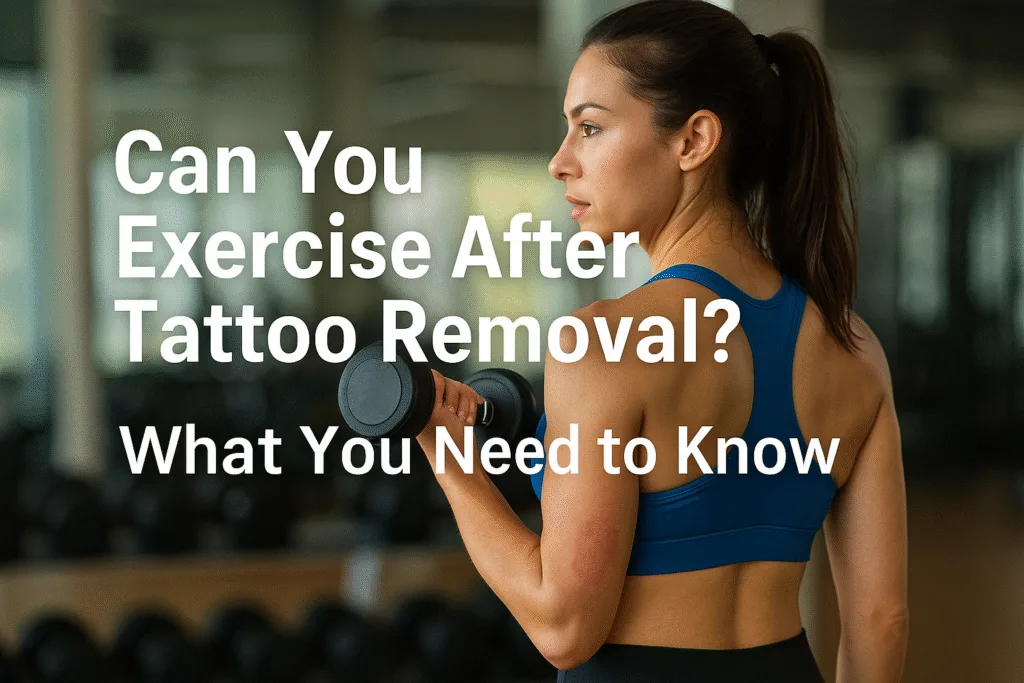If you’re active and health-conscious, you’ve probably wondered about exercise after tattoo removal. The answer depends on the timing and intensity of your workout. Here’s what you need to know to protect your skin and help your body clear ink faster.
Why Exercise After Tattoo Removal Matters
Exercise actually helps your body remove tattoo ink—eventually. Laser removal works by breaking ink particles down so your immune system can flush them out. A healthy lymphatic system and good circulation are key to speeding this up, and movement helps both. But timing is everything.
When to Avoid Exercise
Immediately after a treatment, your skin needs to rest. For the first 24–48 hours, avoid anything that:

- Causes excessive sweating
- Involves friction or tight clothing on the treated area
- Might expose the skin to bacteria, like in gyms, yoga mats, or shared equipment
- Raises your core temperature significantly (like hot yoga or long runs)
During this time, your skin is essentially an open wound. Overheating, chafing, or exposing the area to bacteria can cause blisters, slow healing, or even lead to infection.
When It’s Safe to Get Moving Again
After the first 2 days, light activity is usually safe—as long as it doesn’t irritate the treated area. That means:
- Walking, cycling, or gentle stretching are typically fine
- Use clean, loose-fitting clothing to avoid rubbing
- Always wash and dry the area gently after any activity
- Skip high-contact sports or long sweat sessions until your skin looks fully settled
If your skin is red, blistered, or feels hot after working out, take that as a sign to ease up.
The Hidden Benefit: Lymphatic Support
Here’s the upside—once the skin has calmed down, mild-to-moderate exercise can actually help the removal process. Why?
- Your lymphatic system helps carry away the ink particles destroyed by the laser
- Staying hydrated and keeping your blood moving can improve your body’s ability to flush out ink naturally
Think of it as supporting the internal cleanup crew. Just give it a day or two first.
What to Wear and Watch For
Choose breathable, soft fabrics that don’t press tightly on the treated area. Avoid compression gear or synthetic blends that hold heat and moisture.
Be on the lookout for:
- New swelling or redness
- Blisters that weren’t there before
- Excessive itching, heat, or rash
If you see any of those signs, rest the area, clean gently, and reach out to your removal specialist. Choosing the right clothing is an important part of safely resuming exercise after tattoo removal, especially in warm or high-friction environments.
Pro Tips for Faster Healing
- Hydrate constantly. Your body clears ink fragments through your lymphatic system, which relies on water to function efficiently.
- Get plenty of rest. Quality sleep accelerates skin regeneration and immune response.
- Don’t overdo it too soon. Even if your skin looks fine, deeper healing is still happening. Overexertion too early can trigger inflammation and delay results.
- Cool down wisely. Post-workout, avoid hot showers on the treated area. Use lukewarm water and pat dry gently.
- Support your skin. Consider using natural moisturizers like pure aloe or calendula cream to aid the repair process.
Real-World Scenarios: What Works, What Doesn’t
We often get specific questions from clients about popular workouts. Here’s how some of them stack up after laser tattoo removal:
- Running: Avoid for at least 48 hours, especially if the tattoo is on the legs, ankles, or feet. Sweat, impact, and shoe friction can all irritate healing skin.
- Weightlifting: May be okay after 2–3 days, but avoid using machines or barbells that come into contact with the treated area.
- Yoga or Pilates: Wait a full 3–5 days. Mat-based workouts often involve direct pressure and shared surfaces that could introduce bacteria.
- Swimming: Don’t do it. Pools and hot tubs should be avoided until the area is fully healed—usually 2 weeks minimum.
- Biking: If the tattoo is nowhere near your contact points (like arms if biking), light rides can resume sooner, but avoid heat and sweat buildup under gear.
If you’re unsure, ask during your session. At Black Sage Laser, we tailor aftercare to your lifestyle so you can get back to doing what you love safely.
Your Skin First, Sweat Later
Many clients ask how soon they can resume exercise after tattoo removal without compromising results. Laser tattoo removal is an investment—both financially and physically. Don’t sabotage your progress by jumping back into workouts too quickly. A few days of caution pays off with faster fading and fewer complications.
At Black Sage Laser, we guide every client through post-treatment care—including activity recommendations—based on the size and location of your tattoo.
Have questions? Book a consultation and we’ll walk you through every step.

